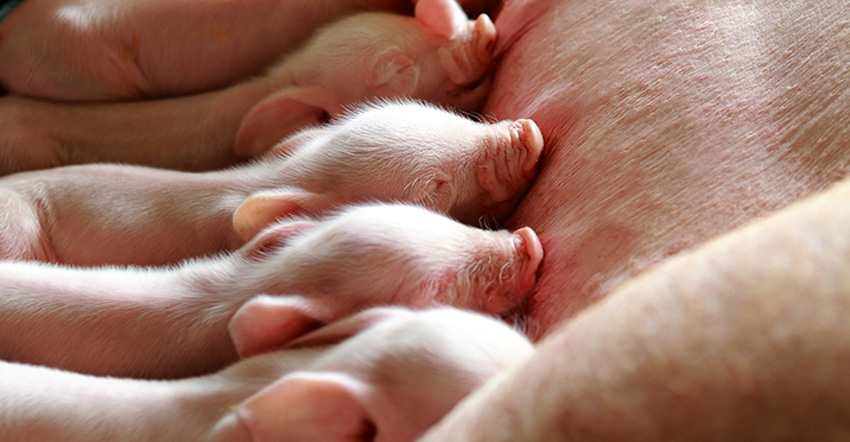Silent Estrus Concerns Remain an Issue in Swine Breeding
Costly ‘Silent Estrus’ Can be Avoided with Proper Estrus and Gilt Age Management
June 15, 2021

Sponsored Content
INTRODUCTION
Good gilt developer management and achieving replacement gilt breeding targets is a part of sustaining profitability in any pork production system.1 Providing the targeted number of pregnant replacement gilts to the system promotes more efficient feed utilization, better herd health and higher quality groups of offspring for grow-out in the nursery and finish phases.2 Recently there have been cases of a higher than normal number of developed gilts that after being added to the breeding area are not showing normal estrus behavior.3 This has led in effected herds to varying and sometimes dramatic decreases in percentages of gilts that are successfully mated and able to conceive. The syndrome is being categorized as a silent estrus problem for the following reasons:
Diagnostics and evaluation of the uterus and ovaries from effected animals and normal animals from effected herds didn’t find evidence of inflammation but found apparently normal ovaries and corpus lutea which indicated normal cycling activity.
The effected gilts fail to show normal cycling behavior. They may show varying combinations of several estrus signs-valval swelling, mucus discharge, interest in boar, behavioral changes-but generally don’t show immobilization or the standing response.
OBSERVATIONS
An accepted case definition of the problem is when a herd sees 3 consecutive weeks of less than 80% of selected gilts expressing normal estrus behavior after 6 weeks of boar exposure. Effected herds are:
70% of selected gilts showing obvious standing estrus compared to the normal of 95%+.
Higher mortality in the gilt pool (up to 9-10%).
An increase in meningitis-associated clinical CNS symptoms in offspring (diagnosed mostly as Strep sp.) and/or conjunctivitis in growing gilts.
An increase in gilts culled prior to farrow which can be as high as 40%+ in some groups and ranges from 15-40%+.
So far, the cause has not been determined and a review of the data has not identified a link to genetics or association with any boar lines. An investigation of the problem at a couple of effected farms initiated by several interested entities and led by Dr. Robert Knox at the University of Illinois has had a few interesting findings. The study assigned gilts to 3 treatment groups based on results of both clinical observation and ultrasound examination. One group received injectable gonadotropin therapy, one group received injectable prostaglandin, and one received altrenogest orally all from commercially sourced products. Some findings related to the above study were:
No estrus gilts were able to grow and ovulate follicles following gonadotropin therapy or from their own hormones after altrenogest therapy.
No estrus or weak estrus gilts that contained a CL responded to prostaglandin treatment.
In effected herds, normal gonadotropin release from the hypothalamus is not occurring in an estimated 40% of prepubertal gilts.
Post-treatment, even though gilts were able to grow follicles and ovulate, normal estrus behavior was absent or poor in 60% of gilts.
CONCLUSION
When using SwineMate®(altrenogest) as part of a gilt breeding synchronization program it is important to follow some important rules related to gilt breeding management:
Gilts must have shown a normal estrus prior to treatment with the product. Swollen vulvas alone are not indicative of a normal heat period. Gilts need to exhibit all the outward signs of estrus including the standing response. Normal hormonal activity must be present in the animal for the product to work.
Make sure gilts are of the proper age at selection. Most commercial breeding stock companies recommend selection at 20-24 weeks of age, boar exposure at 24 weeks, and beginning breeding at 30 weeks.
Limit bad stresses such as crowding and multiple mixes.
Improve quality of boar exposure by considering twice daily exposure which includes actual physical boar-gilt contact.
Use interval verses continual contact to avoid habituation and refractory behaviors.
Use high libido/pheromone boars.
At the time of breeding use more human contact and spend more time in the barn.
REFERENCES
1Stadler, et al. Financial Impact of average parity of culled females in a breed-to-wean swine operation using replacement gilt net present value analysis. JSHAP. 2003; March and April:69-74.
2Scheidt, et al. The effect of all-in all-out growing-finishing on the health of pigs. SHP. 1995; September and October:202-205.
3Cano, Jean Paul. Silent estrus in gilts-what have we learned? Allen D. Leman Swine Conference: September 14-17;St.Paul,Minnesota.
About the Author(s)
You May Also Like



